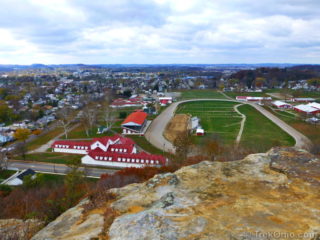 Lancaster, Ohio has a population just under 39,000, and it is the county seat of Fairfield County. It has a municipal park known as "Rising Park." The park offers the normal sort of amenities that you might expect: a pond, picnic tables, playgrounds... things of that nature. But what's unusual about the park is its terrain. Rising 250-foot (76 m) above the surrounding plain is a bluff known as "Mount Pleasant." The bluff is made of highly erosion-resistant Blackhand sandstone. From the top of Mount Read more ➜
Lancaster, Ohio has a population just under 39,000, and it is the county seat of Fairfield County. It has a municipal park known as "Rising Park." The park offers the normal sort of amenities that you might expect: a pond, picnic tables, playgrounds... things of that nature. But what's unusual about the park is its terrain. Rising 250-foot (76 m) above the surrounding plain is a bluff known as "Mount Pleasant." The bluff is made of highly erosion-resistant Blackhand sandstone. From the top of Mount Read more ➜ Rising Park: The View from Mount Pleasant
 Lancaster, Ohio has a population just under 39,000, and it is the county seat of Fairfield County. It has a municipal park known as "Rising Park." The park offers the normal sort of amenities that you might expect: a pond, picnic tables, playgrounds... things of that nature. But what's unusual about the park is its terrain. Rising 250-foot (76 m) above the surrounding plain is a bluff known as "Mount Pleasant." The bluff is made of highly erosion-resistant Blackhand sandstone. From the top of Mount Read more ➜
Lancaster, Ohio has a population just under 39,000, and it is the county seat of Fairfield County. It has a municipal park known as "Rising Park." The park offers the normal sort of amenities that you might expect: a pond, picnic tables, playgrounds... things of that nature. But what's unusual about the park is its terrain. Rising 250-foot (76 m) above the surrounding plain is a bluff known as "Mount Pleasant." The bluff is made of highly erosion-resistant Blackhand sandstone. From the top of Mount Read more ➜ 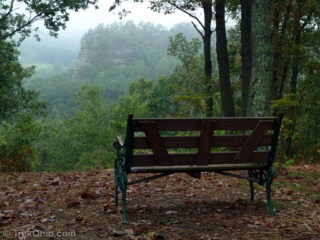 In early September we visited and stayed overnight at a 60 acre private park in Pike County. According to legend we were just a few hundred feet away from the lair of a spectral wolf named Old Raridan.
The area is known as 'Big Rock' after the rocky peak that towers 200 feet above the surrounding country side. A small cave high on the side of the peak was also reputedly the home of the wolf Old Raridan who legend says was killed in an epic battle with local settlers at the end of the
In early September we visited and stayed overnight at a 60 acre private park in Pike County. According to legend we were just a few hundred feet away from the lair of a spectral wolf named Old Raridan.
The area is known as 'Big Rock' after the rocky peak that towers 200 feet above the surrounding country side. A small cave high on the side of the peak was also reputedly the home of the wolf Old Raridan who legend says was killed in an epic battle with local settlers at the end of the 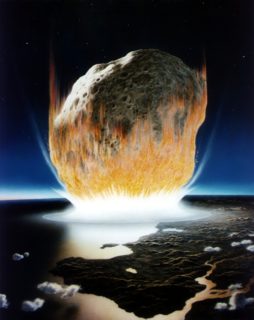 A huge rock hurtles through the empty void of space. Its been orbiting the sun for hundreds of millions of years. But this orbit will be different. This time its trajectory and the orbit of earth intersect. It will impact somewhere in southern Ohio releasing energy equivalent to a large thermonuclear weapon and creating a crater five miles across. Alert the governor, start evacuations! But wait, it's already too late!
It's too late because the impact occurred during the Permian Period
A huge rock hurtles through the empty void of space. Its been orbiting the sun for hundreds of millions of years. But this orbit will be different. This time its trajectory and the orbit of earth intersect. It will impact somewhere in southern Ohio releasing energy equivalent to a large thermonuclear weapon and creating a crater five miles across. Alert the governor, start evacuations! But wait, it's already too late!
It's too late because the impact occurred during the Permian Period 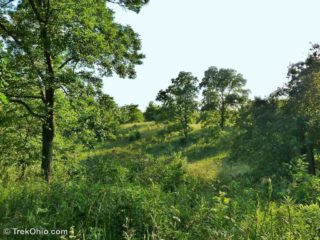 An esker is a special sort of hill. Eskers develop underneath a glacier, so in Ohio they formed during the last ice age. The sediment that eventually creates an esker starts its life as the sand, gravel and rock deposited on the bottom of a riverbed. However the unusual thing about the associated river is that it flows under great pressure beneath a massive glacier. Instead of having normal riverbanks made of earth, this kind of river flows through a crevasse or icy tunnel at the base of a glacier.
An esker is a special sort of hill. Eskers develop underneath a glacier, so in Ohio they formed during the last ice age. The sediment that eventually creates an esker starts its life as the sand, gravel and rock deposited on the bottom of a riverbed. However the unusual thing about the associated river is that it flows under great pressure beneath a massive glacier. Instead of having normal riverbanks made of earth, this kind of river flows through a crevasse or icy tunnel at the base of a glacier. 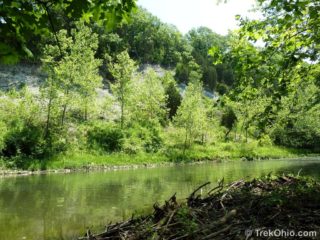 Caesar Creek Gorge State Nature Preserve is located in Oregonia, Ohio just west of Caesar Creek State Park and Caesar Creek Wilderness Area. The nature preserve is downstream from the dam located within the state park. We decided to hike the 2.25-mile trail at Caesar Creek Gorge State Nature Preserve because the preserve's official site stated that the cliff walls making up the gorge rise some 180 feet (54.9 m) above Caesar Creek. The cliffs were formed when huge volumes of torrential, meltwater
Caesar Creek Gorge State Nature Preserve is located in Oregonia, Ohio just west of Caesar Creek State Park and Caesar Creek Wilderness Area. The nature preserve is downstream from the dam located within the state park. We decided to hike the 2.25-mile trail at Caesar Creek Gorge State Nature Preserve because the preserve's official site stated that the cliff walls making up the gorge rise some 180 feet (54.9 m) above Caesar Creek. The cliffs were formed when huge volumes of torrential, meltwater 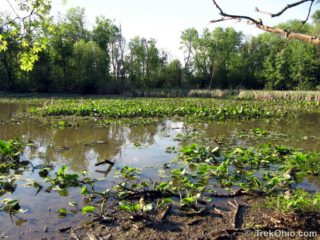 Boyer Nature Preserve is wonderful, mini-wetland that sits in the middle of suburban Westerville, Ohio. The site's main feature is its stream-fed pond. Although it may look like an ordinary pond, it's actually very special due to the way that it was formed. During the last ice age, Westerville was beneath approximately one thousand feet of ice (305 m). As the climate warmed, a large fracture formed near the edge of the melting glacier. Once that fracture became large enough, a huge slab of ice separated
Boyer Nature Preserve is wonderful, mini-wetland that sits in the middle of suburban Westerville, Ohio. The site's main feature is its stream-fed pond. Although it may look like an ordinary pond, it's actually very special due to the way that it was formed. During the last ice age, Westerville was beneath approximately one thousand feet of ice (305 m). As the climate warmed, a large fracture formed near the edge of the melting glacier. Once that fracture became large enough, a huge slab of ice separated 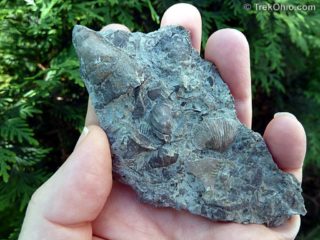 This past weekend, Bob and I went to Caesar Creek State Park to do a little hiking. However once we got there, we happened upon this amazing spillway that was just full of fossils.
In case you are wondering, this is basically a gigantic ditch. The Army Corps of Engineers constructed it to safely channel water from the Caesar Creek Reservoir in the event of flooding. The floor and one wall of the spillway consists of limestone and shale bedrock (dolomite).
The bare bedrock
This past weekend, Bob and I went to Caesar Creek State Park to do a little hiking. However once we got there, we happened upon this amazing spillway that was just full of fossils.
In case you are wondering, this is basically a gigantic ditch. The Army Corps of Engineers constructed it to safely channel water from the Caesar Creek Reservoir in the event of flooding. The floor and one wall of the spillway consists of limestone and shale bedrock (dolomite).
The bare bedrock 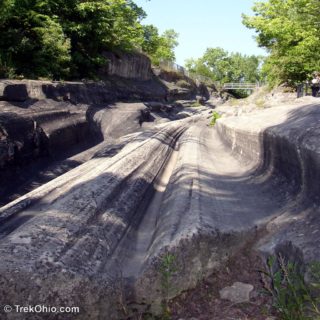 The glacial grooves on Kelley's Island are a designated National Natural Landmark. They were formed during the last Ice Age about 18,000 years ago, and they are the world's largest, known glacial striations. Typically glacial striations are formed when boulders and gravel are dragged across the bedrock under the immense weight of a glacier. Geologists rely on these natural features to determine the direction in which the now-melted ice once flowed. However according to the Ohio Department of Natural
The glacial grooves on Kelley's Island are a designated National Natural Landmark. They were formed during the last Ice Age about 18,000 years ago, and they are the world's largest, known glacial striations. Typically glacial striations are formed when boulders and gravel are dragged across the bedrock under the immense weight of a glacier. Geologists rely on these natural features to determine the direction in which the now-melted ice once flowed. However according to the Ohio Department of Natural  Although reindeer don't live in Ohio now, it was a different story during the last ice age.
Photo courtesy of Dean Biggins of the U.S. Fish and Wildlife Service, license: Public Domain
Reindeer once lived in Ohio.
About 24,000 years ago the Wisconsinan ice sheet expanded into Ohio. Central Ohio was buried under 1000 feet of ice (305 m). Near Lake Erie, the ice was five times thicker. As the ice sheet expanded southwards, all forests in its path were ground to a pulp. Animals from
Although reindeer don't live in Ohio now, it was a different story during the last ice age.
Photo courtesy of Dean Biggins of the U.S. Fish and Wildlife Service, license: Public Domain
Reindeer once lived in Ohio.
About 24,000 years ago the Wisconsinan ice sheet expanded into Ohio. Central Ohio was buried under 1000 feet of ice (305 m). Near Lake Erie, the ice was five times thicker. As the ice sheet expanded southwards, all forests in its path were ground to a pulp. Animals from